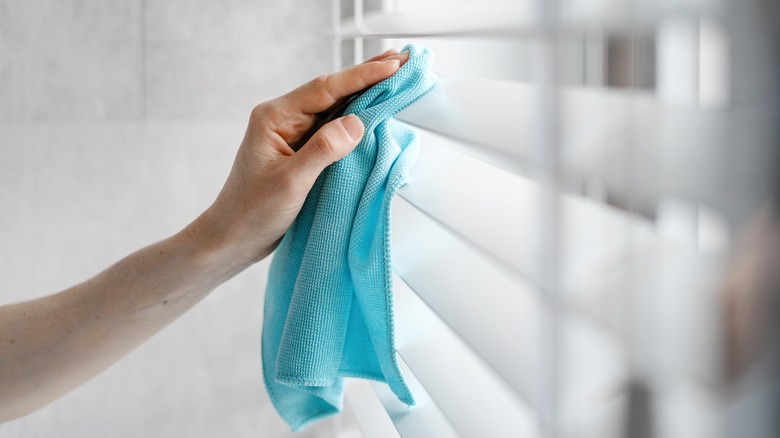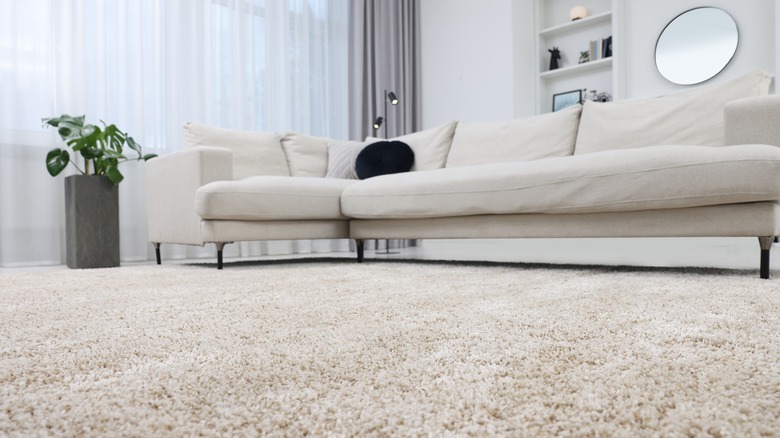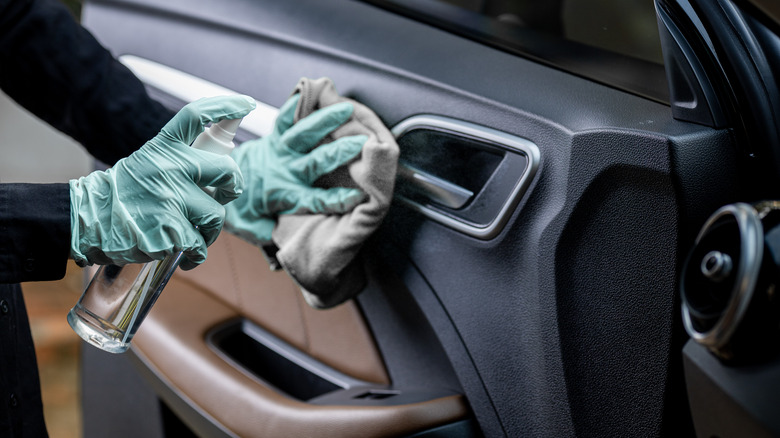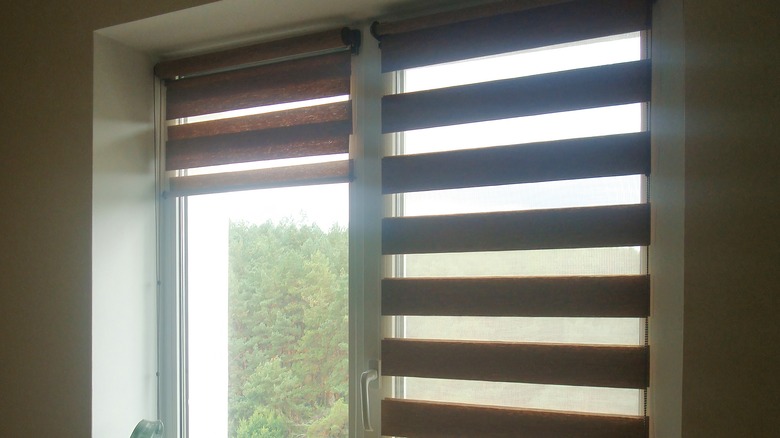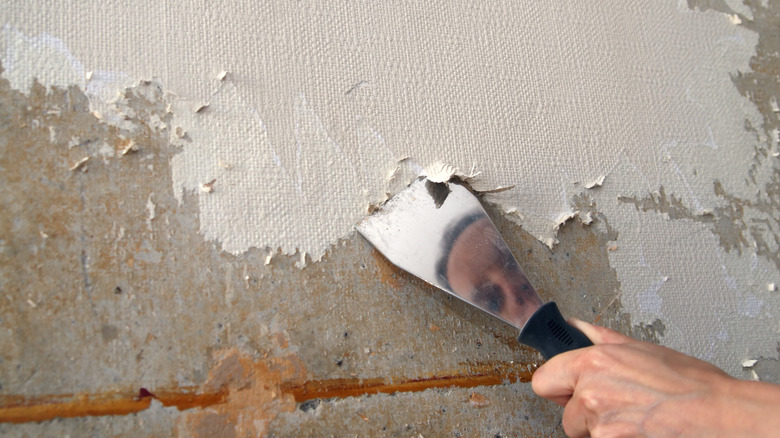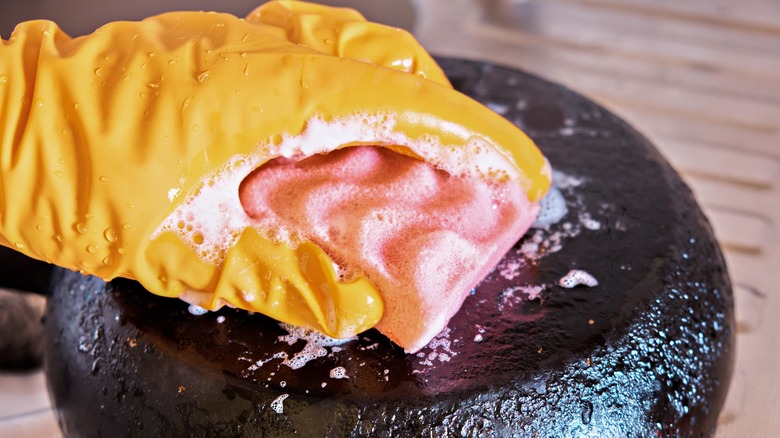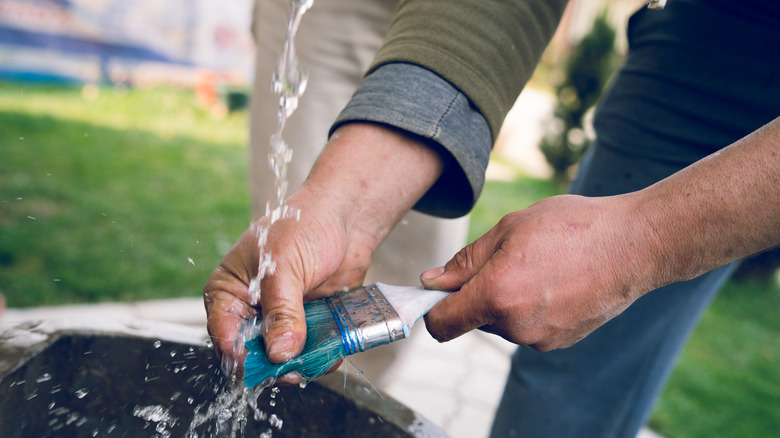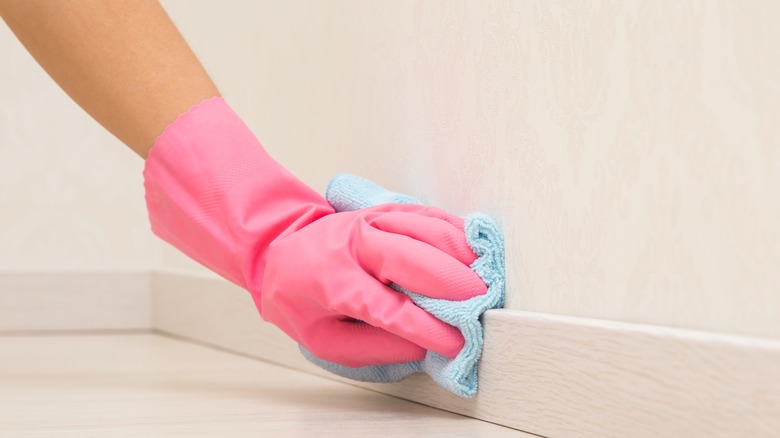Brilliant Ways To Use Fabric Softener Outside The Laundry Room
We may receive a commission on purchases made from links.
Fabric softener is a staple in many people's laundry rooms because it helps soften fabrics and reduce static cling. However, did you know you can use it in more ways than just softening your clothes and towels? Whether you have tough carpet stains or want your home to smell like spring, it acts as a powerful cleaning agent. It can do more than just lubricate fibers, making it more of a workhorse than you originally imagined.
You might be wondering why you would grab your fabric softener from the laundry room rather than just use the all-purpose sprays you already have in your cleaning cupboard. There are several reasons for this switch. First, maybe you want to cut back on how many products you need to buy in order to clean your house. Rather than stocking up on everything from a carpet stain remover to a dust-repelling spray to a car upholstery cleaner, you can just use one product. Second, it might be more effective at cleaning certain things than your designated soaps and sprays. For example, it is impressively good at removing stubborn burnt food on pots and pans, making the chore easier to finish than if you would just use soap and hot water. While fabric softener won't always work as a cleaning and dusting agent, it's still worth trying as an alternative. Intrigued? Here are all the useful ways to use fabric softener outside of the laundry room.
Softening rough carpets
Has your indoor carpeting transformed from a soft, plush pile to something matted and crunchy? You can help soften tough spots with the help of fabric softener. This predicament usually happens due to improper cleaning of the carpet in the first place. If too much soap residue was left behind or not enough water was used to rinse the product out, the fibers stiffen and turn crunchy. To reverse these effects, you first have to rewash the carpet and then rinse it properly. While you can rinse it with a damp cloth, the best method is to use a portable carpet cleaner such as Bissell Little Green to saturate the fibers and then suck away the moisture so mildew doesn't set in.
Then, to soften it, mix 1/2 a cup of fabric softener with 1 gallon of warm water. Spray it either on your entire carpet or select spots that need softening, and allow the mixture to penetrate the fibers for a minute or two. Then, use your carpet cleaner to rinse it out with clean water and extract it dry. This hack works because carpets are often made with fibers similar to our clothing — wool, cotton, and polyester. Because of this, the conditioners in the fabric softener will work the same way on the carpet fibers as they do on your sweaters and t-shirts. However, just ensure you don't add more than a 1/2 cup of softener to your solution. Adding too much to the mixture can cause a sticky film to be left on the pile, which will not only result in the same crunchy problem you started with, but also act as a magnet for dirt and debris.
Cleaning your car
Your car is used a lot, so over time, dust, crumbs, and stains accumulate. Paying for detailing is effective, but if you would rather save the expense, you can easily clean it yourself. While there are plenty of car maintenance products on the market, you can also use fabric softener sheets if you don't have any of those specialty sprays on hand. Whether your dashboard needs a good dusting or you have a lot of bug residue on your windshield, fabric softener can help.
For example, if your dashboard seems to collect dust and grime in the span of a few days, you can help reduce the amount you see by using dryer sheets. Clean your dashboard using the products you normally do, but then wipe a fabric softener sheet across it to create a dust-repelling barrier. This will push the dust off your dashboard and onto the floor below, making it appear cleaner for longer. This works because the conditioners in the sheets have positively charged ions, which not only reduce static cling in clothes but repel dust that would try to settle on the surface. Dryer sheets can also help with dead bugs on your windshield or finish. Jim Eberle, a car wash owner, told ABC13 that an effective way to remove them without needing to scrub and scrape is to wet a fabric softener sheet and use it as a sponge. The bugs will come right off. If you do this on the body of your car, just make sure to re-wax the areas you cleaned, as this can remove some of its top-coat.
Dusting blinds
Dust build-up is aggravating and hard to avoid. The accumulation over time requires routine cleaning to prevent unwanted sneezing and eye-watering. There's a plethora of common dusting brands for blinds, but if you prefer to use what you already have, this fabric softener hack is for you. The genius behind it doesn't have much to do with its cleaning properties since fabric softener isn't a surfactant. It only conditions and reduces static — but it's its static-repelling properties that you're after.
For this hack, you want to use fabric softener sheets on your window blinds. Use them like you would a microfiber cloth, wiping away the dust off of each individual blind slat. Not only will this remove the dust particles, but it will leave behind a thin coating that will repel future dust from settling onto the surface, instead pushing it down to the floor. This will help you cut down on how often you will need to wash them, making the task a little less cumbersome.
Removing wallpaper
Removing wallpaper takes time and patience if you don't want to rip your drywall in the process. But fabric softener can help you remove it without any excess tears or holes. The only caveat to this hack is that it won't work on every type of texture. For example, some wallpapers are water resistant, like vinyl, and would need a chemical wallpaper remover. But if you're working with traditional wallpaper, fabric softener diluted with water will be your best bet.
The product helps by softening the glue that bound the wallpaper to the wall. This helps it slide off much easier, reducing the risk of accidentally tearing the drywall underneath. To utilize this hack, first remove as much of the wallpaper as possible by hand. Once you only have the stubborn scraps and glue left on the walls, mix a 1:1 ratio of fabric softener and warm water in a spray bottle. Saturate the walls with it, and give it about 15 minutes to penetrate the glue. Then, use a putty scraper to remove the paper and glue.
Restoring burned pans
Burned pots and pans make washing up a hassle, especially when you can't properly remove the charred bits. This usually leads us to scrub the pots until our arms hurt, and even then, some black spots remain. Rather than exhausting yourself with the task, you can make the entire chore easier by utilizing a fabric softener sheet. It might sound odd to use a laundry staple to clean a burnt pan, but the anecdotal results don't lie. To do so, fill the pot or pan with hot water, add a squirt of grease-fighting dish soap in it, and put a fabric softener sheet over the mess. Let it soak for a few hours, and then rinse the pan. Most of the food and grease should come off with the rush of water, but if there is still some attached to the bottom of the pan, use the sheet like a sponge to remove the rest.
Donna Smallin Kuper, author of "Cleaning Plain & Simple," told Today that this hack most likely works due to the waxy conditioners in the sheets. She hypothesizes that they soften the scorched food and caked-on grease, making it easier to wash those messes away. Just make sure to wash the pot once more afterward with soap to remove any lingering residue from the sheet. This is important since the pot or pan will later be in contact with food, and the chemicals could transfer.
Cleaning paint brushes
Are you in the middle of repainting a room or doing some light touchups on trim or patched drywall holes? If you're not an expert painter or handyperson, then you might have battled with your fair share of crusty and crunchy paintbrushes. If you don't wash them properly after each use, bristles become caked with poorly removed paint, making them stiff and less effective. But have no fear — fabric softener can help. Contractors and paintbrush brands alike endorse this hack, so it's worth a try.
Next time you're done painting for the day, rinse your brushes in the sink without using any soap. Try to remove as much paint as you can. Then, dilute 1/2 a cup of softener with 1 gallon of warm water, and dip and agitate your brushes in the solution. This will not only help remove the remaining paint stuck to the bristles, but it will also coat the brush with conditioners, ensuring they're soft for the next day's work.
Dust your baseboards
You might not notice grime buildup on your baseboards like you would a thin layer of dust on a table, but over time, the dust will accumulate and demand your attention. However, since they're so low to the ground, not many people like cleaning them. You need to get on your hands and knees, and they usually circle the entire length of a room. This not only means there is a lot of surface to clean, but they also dip behind furniture, requiring you to move things around to access them. Because of this, it's in your best interest to clean your baseboards in such a way that will repel future dust from settling on them as frequently, allowing you to get away with cleaning them fewer times throughout the month. That's where fabric softener comes in.
Similar to dusting blinds, the softener will leave behind a waxy barrier with a positive ionic charge that will repel dust from settling on top of it. Instead, the particles will float down to the ground, where you can easily vacuum or mop them up. To utilize this hack championed by cleaning companies and folks with anecdotal success, first clean your baseboards with a wet microfiber towel to remove any dirt buildup. Then, rub a dryer sheet across your baseboard, paying special attention to any grooves where dust and dirt like to settle. Rub it so a thin coating is left behind, ensuring the protective barrier is in place. You should notice less dust settling onto them in the next few weeks.
